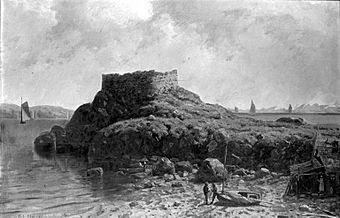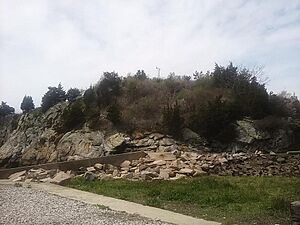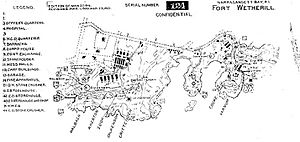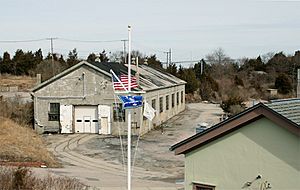Fort Wetherill facts for kids
Quick facts for kids Fort Wetherill |
|
|---|---|
| Part of Harbor Defenses of Narragansett Bay | |
| Jamestown, Rhode Island | |

12-inch gun on disappearing carriage, similar to those at Fort Wetherill.
|
|
| Type | Coast Artillery Fort |
| Site information | |
| Controlled by | United States |
| Site history | |
| Built | 1895–1903 |
| In use | 1900–1945 |
| Materials | reinforced concrete |
| Battles/wars | World War I, World War II |
| Garrison information | |
| Past commanders |
Col. Earl C. Webster |
|
Fort Dumpling Site
|
|

Fort Dumpling, Rhode Island by George L. Clough, Brooklyn Museum
|
|
| Location | 3 Fort Wetherill Road Jamestown, Rhode Island |
| Built | 1800–1941 |
| Architect | United States Army Corps of Engineers |
| NRHP reference No. | 72000021 |
| Added to NRHP | March 16, 1972 |
Fort Wetherill is an old military fort on Conanicut Island in Jamestown, Rhode Island. It sits on tall granite cliffs, looking out over Narragansett Bay. Before Fort Wetherill was built, a fort from the American Revolutionary War called Fort Dumpling stood here.
After World War II, Fort Wetherill became a state park. It's now a 51-acre (210,000 m2) park managed by the Rhode Island Department of Environmental Management.
Contents
Fort Wetherill's Early History
In 1776, American forces built a dirt fort with 8 guns at Dumpling Rock. This spot was important because it overlooked the East Passage towards Newport. American, British, and French soldiers used this old fort during the American Revolutionary War.
The Americans called it the Dumpling Rock Battery. The British called it Fort Dumpling Rock. In 1779, the British left Newport and the fort. After that, it was called Fort Conanicut.
In 1798, construction started on a stronger fort at Dumpling Rock. Major Louis de Tousard from the United States Army Corps of Engineers oversaw the work. This new fort was officially named Fort Louis, then Fort Brown. But people usually called it Fort Dumpling.
Fort Dumpling was a round stone tower. It was often shown in art and used for social gatherings. A report in 1811 described it as a "circular tower of stone, with casemates." Casemates are armored rooms for guns.
Modern Fort Wetherill
In 1899, the U.S. government bought more land. They built Fort Wetherill where Fort Dumpling used to be. Fort Wetherill became the largest fort protecting Narragansett Bay. It was named after Captain Alexander Macomb Wetherill, a local hero. He was killed in action during the Battle of San Juan Hill.
The building of Fort Wetherill destroyed Fort Dumpling. The new fort had many concrete spots for modern guns. These were 20th-century guns that loaded from the back.
In 1901, Battery Varnum was the first modern gun area finished. It had two large 12-inch guns. By 1910, six more batteries were ready for use. Many of these old gun areas are now covered with plants. But they show a very long line of concrete gun positions.
Fort Wetherill During World Wars
During World War I, five companies of the Rhode Island National Guard were stationed at the fort. After the war, only one soldier was left to watch over the fort.
In September 1940, the U.S. Army reopened Fort Wetherill. It became a key part of the Harbor Defenses of Narragansett Bay. New buildings were built for 1,200 soldiers. The fort also trained soldiers before World War II. Later in the war, it trained German prisoners of war.
By 1943, most of the fort's big, old guns were removed. Newer, stronger defenses were built at Fort Greene and Fort Church. In 1946, the U.S. military stopped using Fort Wetherill. The site was empty for about 25 years.
Becoming a State Park
The State of Rhode Island bought the fort on August 16, 1972. They turned it into a state park for everyone to enjoy. In 1972, the fort was also added to the National Register of Historic Places.
Today, the park is still popular with visitors. It has walking trails through woods and along the rocky coast. It's also a favorite spot for scuba diving.
Submarine Mine Operations
Fort Wetherill also has old buildings and a tramway system. These were used for a submarine mining operation. This operation ran from the fort during World War I and World War II.
During World War II, about 300 mines were placed around Conanicut Island. These mines protected the waters near Newport. Most of them were managed from the Mine Wharf at Fort Wetherill.
The old mine storehouse is still there. It's one of the best preserved in the United States. You can see the remains of the tram tracks. These tracks carried the huge mines in and out of the building. Boats would pick up the mines at the wharf. They would then take them out to the water and place them with their electric cables. When mines needed to be brought back, they were taken to the wharf. Then they traveled on the tramway to different service buildings.
A special station sat on the hill. From here, spotters watched for enemy ships. They could see ships approaching the minefields. Then they would signal to operators to set off a mine electrically.
Fort Wetherill's Guns
Starting in the early 1900s, seven main concrete gun batteries were built at Fort Wetherill. During World War II, a new battery called AMTB 923 was added. It had four 90 mm guns. Two were fixed in place, and two could move. It also had two 37 mm guns. Another battery, AMTB 924, had two mobile 90 mm guns.
Only Batteries Dickenson and Crittenden were used during World War II. New, very powerful 16-inch guns at Fort Church and Fort Greene replaced most of Fort Wetherill's older guns.
The main gun batteries at Fort Wetherill were:
| Name | Number of Guns | Gun Type | Carriage Type | Years Active |
|---|---|---|---|---|
| Varnum | 2 | 12-inch gun M1888 | barbette M1892 | 1901–1943 |
| Wheaton | 2 | 12-inch gun M1900 | disappearing M1901 | 1908–1943 |
| Walbach | 3 | 10-inch gun M1888 | disappearing M1896 | 1908–1936 |
| Zook | 3 | 6-inch gun M1903 | disappearing M1903 | 1908–1917 |
| Dickenson | 2 | 6-inch gun M1900 | pedestal M1900 | 1908–1947 |
| Crittenden | 2 | 3-inch M1902 seacoast gun | pedestal M1902 | 1908–1946 |
| Cooke | 2 | 3-inch gun M1898 | masking parapet M1898 | 1901–1920 |
| AMTB 923 | 4 | 90 mm gun | two fixed, two mobile | 1944–1946 |
| AMTB 924 | 2 | 90 mm gun | mobile | 1944–1946 |
Naming the Batteries
Many batteries were named after important military figures.
- Battery Varnum was named for James Mitchell Varnum, a Revolutionary War general.
- Battery Wheaton was named for Frank Wheaton, a Civil War general.
- Battery Walbach was named for John de Barth Walbach, an officer who fought in several wars.
- Battery Zook was named for Samuel K. Zook, a Civil War general.
- Battery Dickenson was named for George Dickenson, an artillery officer killed in the Civil War.
- Batteries Crittenden and Cooke were named for officers killed in the Battle of the Little Bighorn.
Changes to the Guns Over Time
After the U.S. entered World War I, Battery Zook's three 6-inch guns were taken away. They were sent to the Western Front in 1917 to be used as field guns. They never came back to the fort.
Battery Walbach's three 10-inch guns were also removed in 1917. They were planned to be used as railway guns. Two were put back, but one was moved to Fort Greble in 1918. The last two guns were moved to Fort H. G. Wright in New York in 1936.
Battery Cooke's guns were removed in 1920. Battery Crittenden's guns were stored in 1925. They were replaced by two 3-inch guns from Fort Adams.
Battery Varnum's guns were scrapped in 1943. This happened as new, larger 16-inch gun batteries were finished. Battery Wheaton's guns were also likely removed then.
Battery Dickenson was kept in use throughout World War II. Its guns could track enemy ships better than older types. It used radar data from Brenton Point to help aim its shots.
Fort Wetherill Today
Fort Wetherill is now a state park in Rhode Island. It's a great place for sightseeing. People often visit to watch the Tall Ships Challenge event in Narragansett Bay. It was also popular for the America's Cup sailing races before 1984. The park has parking, restrooms, and picnic tables.
As of 2016, many parts of the old gun batteries have been partly buried for safety. The concrete surfaces show signs of decay. The mine storehouse area is well preserved. It has signs that explain the mine and net defense systems used in Narragansett Bay. As of 2020, much of the fort's surface is covered in graffiti.
Images for kids




















